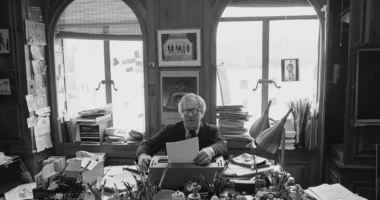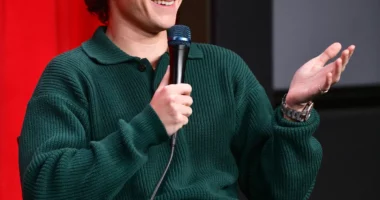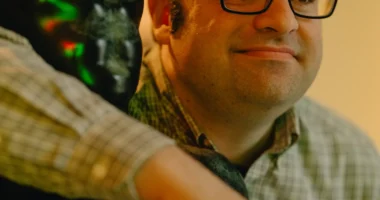There’s telling a bad joke. There’s bombing. And then there’s what happens to Nathan Fielder’s character, Asher Siegel, at the end of the fourth episode of “The Curse,” near the halfway point of a series that goes to disorienting extremes.
Siegel and his wife, Whitney (Emma Stone, in a remarkable comic performance), are making an HGTV show about eco-friendly renovations. After a focus group takes issue with Asher’s sense of humor in the show’s pilot, he finds himself in a comedy class where an instructor assigns an exercise: Get laughs without saying a word.
In the episode, which premiered last weekend on Showtime and Paramount+, the camera swirls around a circle of students mugging for chuckles until it focuses on Asher, looking nervous in anticipation of his turn. You feel for him. In his finest performance to date, Fielder plays a guy who prides himself on being funny but deep down has doubts. Suddenly, in a quick flourish, he grabs his ears and flaps them while emitting a piercing squeak that could be described as unholy. No one laughs. But this face is more than unfunny. It’s unsettling, almost feral, working like a jump scare more than a punchline. It’s a gesture gone so wrong, it’s destined to become a meme.
The year began with hit movies like “M3gan” and “Cocaine Bear” that pushed horror into camp comedy. It’s ending with a nervy television series that moves in reverse. It’s been called cringe comedy, and there are funny moments, but they set up something darker and dread-filled, potentially supernatural. Fielder has always toyed with genre, elevating prank comedy and using reality television to make unexpectedly moving drama. He’s leaning on the tools of horror here. With “The Curse,” the jangly sound design, manipulative cinematography and periodic bursts of oddball monstrousness offer a few of the creepiest moments of the year.
While the plot is involved, with several threads, its engine is a classic horror trope: Is this supernatural-seeming thing of the title for real?

“Rosemary’s Baby” and “Get Out,” among other movies, both invite the viewer to ask this question along with their paranoid protagonists.
Sign up for the Watching newsletter, for Times subscribers only. Streaming TV and movie recommendations from critic Margaret Lyons and friends. Try the Watching newsletter for 4 weeks.
Asher possibly enters the realm of the fantastical after balking at the criticism that his plan to “consciously rejuvenate distressed homes” is gentrification. “We don’t believe the G word has to be a game of winners and losers,” he tells a journalist. Rattled by this exchange and concerned about his image, he summons his camera crew to film his giving a $100 bill to a small Black girl. Then when the camera stops rolling, he asks for it back. She responds by saying she is putting a curse on him, which he initially brushes off but gradually becomes obsessed with. Whether Asher is actually cursed hovers over the entire 10 episodes until a twist in the final episode that should polarize the audience.
In “Psycho,” Alfred Hitchcock proves that the easiest way to make us empathize with a killer is to keep the camera on him. Even when Norman Bates is trying to cover up a murder, audience members will eventually, if managed right, find themselves gravitating to his side. Fielder has always been preoccupied with this emotional power, the distorting impact of the camera, not only on its subjects but on viewers, too. It’s easy to sympathize with Asher’s struggles as he navigates a skeptical press, his troubled new marriage and a bullying father-in-law as well as his craven producer, played by Benny Safdie. “The Curse” keeps complicating this identification, subverting and questioning it.
In Episode 3, Asher’s stern face is cast in a shadow at an auction as he buys a home he didn’t realize is housing the girl who cursed him. A scene in which he uses a drill to open her door is played for terror, focused on her cowering inside. The rumbling power tool and the fear on her face cast this as a classic home invasion scene with Asher as the terrifying intruder. His stated good intentions are repeatedly mocked in the ominous way his scenes are shot.
This draws attention to the Siegels as privileged outsiders casually entering and destroying a new neighborhood in the guise of liberal do-gooder assistance. The focus doesn’t just hit the theme of gentrification, but also, in a subplot involving an Indigenous artist, the genocide and exploitation that built this country.

It’s heavy stuff but not always on the surface. “The Curse” has many long, mundane set pieces that double as metaphors. Take the physical comedy of Asher helping Whitney to take off her sweater as they fall over each other. They try to recreate the funny moment for the cameras. But it doesn’t work, so they try again, emphasizing more strain and resistance. It’s a sharp satire of how people fake struggle for clout and approval.
The show is full of goofy humor about tragic subjects, a cartoon about oppression, a Holocaust joke. The main plot is just the old story of vain fools trying to make a show, but grim subtext comes through in the formal qualities of the show.
For instance, shots are commonly filmed through a window from the outside looking in. Instead of bringing us into a vehicle where Fielder and Stone are talking, the camera is placed beyond the closed car window, in traffic. Most of a scene in a hospital room is viewed through the door or window. So much of “The Curse” takes place outside planes of glass that the mirrored glare is a signature of its aesthetic.
This has an alienating effect, giving the sense that we’re only seeing part of the picture, a distorted one at that. But there’s also something creepily voyeuristic about the shot, a cool detachment, the sense that everyone is under a microscope. It evokes the most famous shot in all of horror: The classic slasher point of view, used most famously in “Halloween,” where we share the perspective of the serial killer looking through a home’s window.
But there’s something about a peeping-tom perspective that adds authenticity. It comes off as less staged and slick than most television and thus more real. Does that make it more fake or less? Fielder has always loved exploring this question. “The Curse,” his most scripted show yet, is continually shifting between comedy and horror as well as naturalism and the fantastical. The lines are much blurrier than we think, but on this show, that’s where the action is.
After his monstrous face in class, Asher looks humiliated. But also taken aback, as if he revealed more than he wanted or knew was there.






